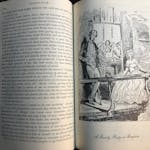Stories. We escape into them. We emulate characters from them. We use them to structure history and religion and psychology, to move our spirits and to give our lives meaning. Everybody loves stories.
Or so we think. In Iain Pears' new novel, "Arcadia," the ruling elite of a Dystopian future world in which society is scientifically managed have no time for stories — or emotions, or anything but the most utilitarian means of creating and improving production. Implants and drugs keep society running smoothly; those who reject the drugs and try to preserve art and literature and history — particularly history — are banished as Renegades, sent to internment camps or, in semiregular purges, slaughtered.
"Arcadia" is a complex romp through time and genres (in the words of the author, "a spy story, a fantasy, a historical novel, a romance, a mythology and a work of science fiction … a meditation on literature and narrative, or just a lighthearted romp") that intertwines 10 major characters over several centuries, with allusions abounding to Tolkien, C.S. Lewis, Shakespeare and a raft of others. Even John Le Carre makes a cameo appearance.
In essence, though, the complexity reduces to the conflict between those who love stories and those who think humanity is better off without them — between the humanists and the technocrats.
The main settings are Oxford in the 1960s, the Dystopian world of the future and a seemingly archaic utopia called Anterworld, a fictional world created by an Oxford don of the Tolkien variety. In Anterworld, the don — Prof. Henry Lytten — creates a bucolic society set in an indefinite (until the end) time frame, in which the Storyteller is the most significant person of all and students spend decades studying The Story, translating it, memorizing it, learning its commentaries and interpretations.
Back in the Dystopia, Angela Meerson, a brilliant scientist at a third-rate scientific station, has invented a machine intended to transport people to parallel universes to ease overpopulation and exploit resources. Instead, she discovers, it is a time machine. Fearing that it is too dangerous to fall into the hands of corporate overlords, she transports herself and her data back in time, meeting Prof. Lytten and even working a bit for MI5. As an experiment, she brings Anterworld to life, meaning for it to be a purely static world she can observe, then eliminate. When 15-year-old Rosie enters the world, it begins creating itself in reality.
Such are the bare bones of the story, which was originally conceived as a digital work and can be read on an app (IOS devices only). In a piece in the Guardian, "Why You Need an App to Understand My Novel," Pears explains he wanted "to make my readers' lives as easy as possible by bypassing the limitations of the classic linear structure. Once you do that, it becomes possible to build a multi-stranded story … where each narrative is complete but is enhanced when mingled with all the others; to offer readers the chance to structure the book as best suits them." (Read the story at tinyurl.com/ovmgavb.)
The app resembles a subway map, with separate lines for each character's narrative (the Professor's Tale, the Assistant's Tale and so on) and nodes where the stories converge. It is an attractive map, and the app does come with bonus material. Paradoxically, though, the "classic linear structure" Pears tries to subvert is even stronger in the app. I would recommend reading the print version, in which the narratives shed reciprocal light on one another as they accrete details together. It is much more fun to puzzle out how all the strands fit together than to read each one linearly, at least for this reader.
Patricia Hagen teaches English at the College of St. Scholastica in Duluth.




